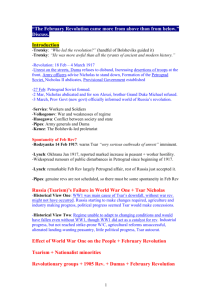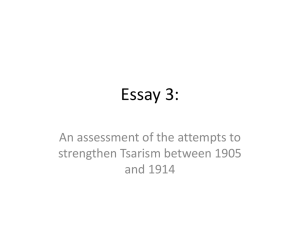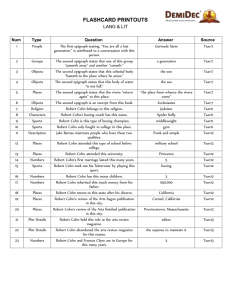Discontent and Opposition to the Tsar
advertisement
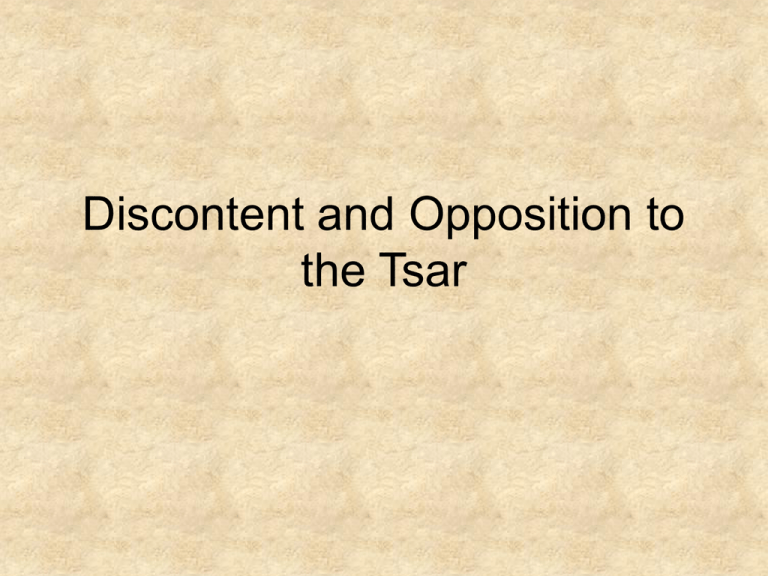
Discontent and Opposition to the Tsar The nature of Russian society in 1914 • Russia is a vast country stretching from the Eastern European plain, across the Ural Mountains and the plains of Siberia to the Far East. • Approximately 110 million people lived in Russia in 1900, 97 million of which were peasant farmers, three million were industrial workers • About one million made up the aristocracy and approximately half a million were from the professional classes. • Russia was socially and economically backward in contrast to the other Great Powers, although it was beginning to undergo rapid industrialisation in the cities as it tryed to catch up with the USA, Germany, Great Britain, France and Japan. • The vast majority of Russians were peasant farmers who lived an almost medieval existence - dependant upon the soil and the local aristocracy. • By 1900 the peasantry was growing rapidly and there was a hunger for land that was mainly owned by the aristocracy. The government of Nicholas II in 1914 • The Romanov Tsar Nicholas II, was an absolute monarch who ruled from St Petersburg. • This situation changed Following a revolution in 1905 when the Tsar was forced to accept the establishment of the Duma, a Russian parliament. • However, this organisation was weak and essentially rubber-stamped decisions made by the monarchy and its council. • Although the Duma theoretically limited Nicholas II’s power, he could still be described as an absolute monarch with absolute power over the Russian people. • The Romanov dynasty maintained its position through the traditional loyalty of powerful sections of Russian society: Traditional loyalty – The most important of these were the aristocracy, the Church, the bureaucracy, the police and the Russian army. – Each of these powerful elites was interested in preserving their own positions and the power of the monarchy. • By 1914 Russia seemed to be very old fashioned, even medieval, in contrast to the other Great Powers. Opposition groups • Opposition groups such as Kadets, Social Revolutionaries and Social Democrats were suppressed and many of the Tsar’s political enemies were forced to live abroad. • The Kadets, (Constitutional Democrats) were a middle-class liberal party that wanted peaceful political change leading to the handover of power to an elected duma. They were the most moderate of the opposition groups. • The second major opposition group were the Social Revolutionaries wanted to seize power by revolution. They would change the system of land ownership to make life better for the peasants. • The third group were the Social Democrats. They followed the communist the writings of Karl Marx. He predicted that workers would rise up against the middle and upper classes and seize control of the means of production (factories and land). Eventually a classless society would be created - communism. • The communists aimed to overthrow the Tsar, the aristocracy and the Church and replace them with small councils or Soviets, which would represent the ordinary people and control the means of production on their behalf. • The communists were split amongst themselves: – The Bolsheviks, led by Vladimir Ilyich Ulyanov, or Lenin. who believed a communist revolution in Russia could only be achieved by a small elite of professional revolutionaries under his command. – The other communist group were the Mensheviks. The Mensheviks also wanted a communist revolution, but one that was democratic and not controlled by one person or a small group. The Tsar’s Opponents and Supporters Against the Tsar For the Tsar The Kadets The nobles The Social Revolutionaries The Church The Social Democrats The wealthy middle class The Bolsheviks and the Mensheviks, (after 1903) Many peasants and workers who were traditionally loyal to the Tsar. The Tsar’s response to opposition • He could be completely ruthless to people who protested. • He used the army to put down street demonstrations • He had a highly effective secret police force called the Okhrana • Once arrested suspects could be tortured, imprisoned or sent into exile in a remote part of the country. • The work of the Okhrana kept illegal opposition groups weak and disorganised. • By the early 1900s most of their leaders had fled abroad. First World War The First World War was a disaster for Russia. Many Russians laid all the blame on the Tsar and came to see his overthrow as the only way to save the country from a crushing defeat. Discontent by 1916 • Russia was losing the war: – It was impossible to supply the huge army of 6 million men, with Russia’s small amount of industry. – Inefficiency and corruption of Tsar’s adminstrators led to waste & confusion – Transport system could not cope supplying both towns and the army – Army used outdated tactics and its generals were poor leaders. • In 1915 the Tsar made himself Commander-inChief of the army – now soldiers could directly blame him for their misery and the high casualties. Discontent by 1916 • The Tsar left the running of the country to his wife the Tsarina: – She refused to take any advice from the Duma so she was blamed for everything that went wrong. – The Tsarina was German – this made her unpopular – rumours she was trying to sabotage the war effort. • The Tsarina listened to Rasputin: – His character and the many scandals made him unpopular. – Some believed he had a satanic hold over the royal family and he was leading Russia to her doom. – Wild rumours that they were both German agents – He was murdered in December 1916 but by this time it was too late Crisis in the Cities • Throughout much of the war, Russian cities suffered from a shortage of food: – Bad harvests – Poor transport arrangements – Loss of large areas of rich farmland to the Germans • The shortage meant food prices went up 700% in 3 years of war, but wages only increased 200%. • By the beginning of 1917, workers in towns were faced with starvation.

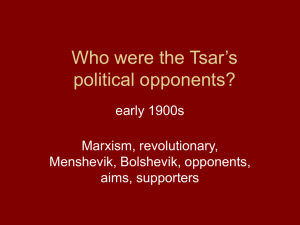
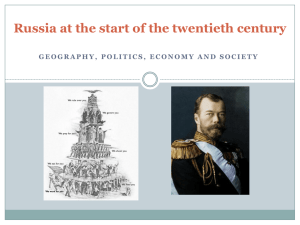
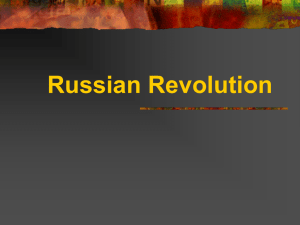
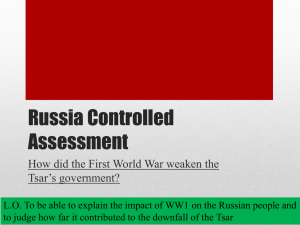
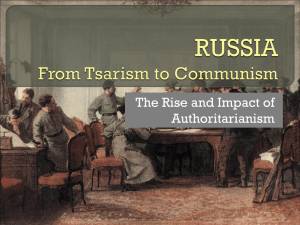
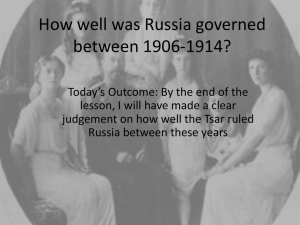
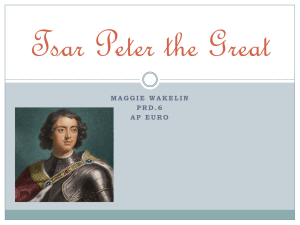
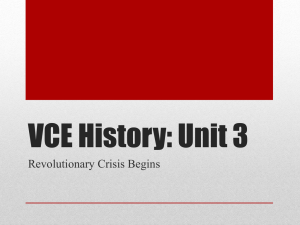

![Student 1 Response [DOC 58KB]](http://s3.studylib.net/store/data/007884700_2-ac84108a439c92f71985944d36c8ac53-300x300.png)
